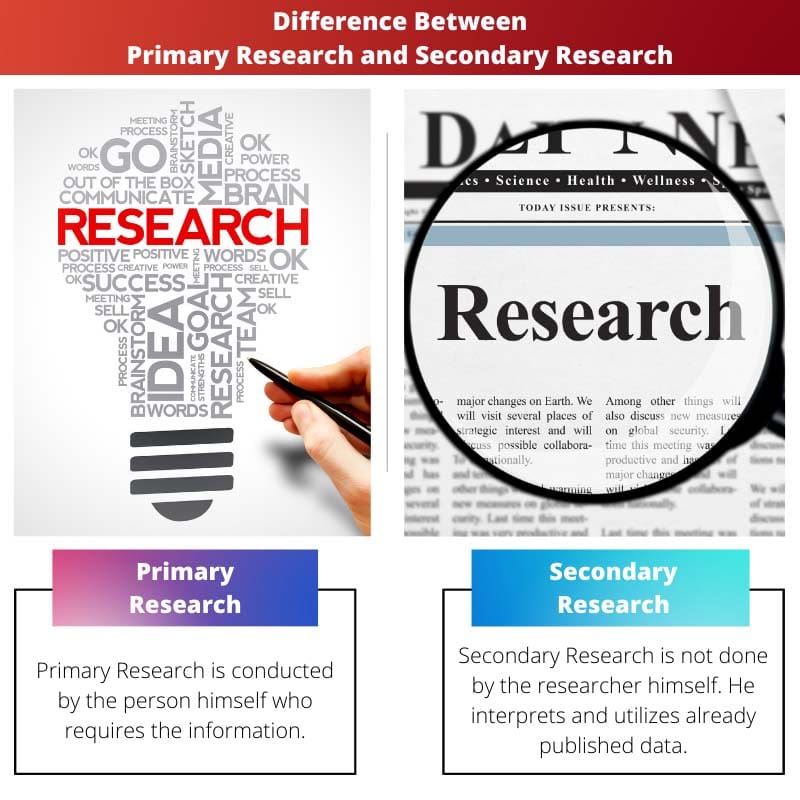In an ever-changing world, it is always necessary to conduct a proper search, an in-depth finding of information for exploration, elucidation and interpretation. Doing research permits one to refute the false and defend the truth.
It fills the knowledge gap and helps one to adopt new and effective ways for smooth functioning and monitoring progress. There are two ways by which the objective of Research: Primary Research and Secondary Research.
Key Takeaways
- Primary research involves collecting original data directly from participants, while secondary research analyzes existing data from previously published sources.
- Primary research provides a more tailored approach to answering specific questions, while secondary research is more cost-effective and time-efficient.
- Primary research allows for greater control over the research process, while secondary research relies on the quality and accuracy of the data collected by others.
Primary vs Secondary Research
The difference between primary and secondary research is that the former collects first-hand, original data from the source while the latter involves analysis and gathering information from primary research data, i.e., from first-hand raw data. Primary research involves systematic conduction of research, whereas secondary research doesn’t include any proper research.

Primary Research is referring to the record of first-hand raw data collected from the survey. It includes reaching the source of information or the field of the survey to collect the information tailored to the requirement of research.
Secondary Research refers to the gathering and analysis of information that has already been collected from the source of origin earlier. The data which is used in the secondary research had previously been collected for the other research goals.
Comparison Table
| Parameters of Comparison | Primary Research | Secondary Research |
|---|---|---|
| Conducted by | Primary Research is conducted by the person himself who requires the information. | Secondary Research is not done by the researcher himself. He interprets and utilizes already published data. |
| Source | Surveys, door to door questioning, interviews, etc. are the sources of primary research. | The researcher finds information from already gathered and published sources, such as journals, dissertations, etc. |
| Research objective | It is conducted for the collection of raw data for the specific goal at hand. It is tailored for that purpose only. | The objective of secondary research is to gather information from various antecedent materials. |
| Cost and Time | It involves high cost as it needs to gather from sources. And it is a time-consuming process. | It is a very economical method of doing research and requires less time for assembling data. |
| Tools involved | The tools used to conduct this are questionnaires, interviews etc. as it is more dependent on interaction. | The tools used here are mobile, laptop and other electronic devices with internet facility. |
What is Primary Research?
When the research demands the direct involvement of the researcher, it is known as Primary Research. The researcher collects raw data on his own and according to his requirement.
The data collected is absolutely under the proprietorship of the researcher and is always accurate. Doing primary research helps researchers to be in a higher position in that field.
Afterwards, whenever the data collected from primary research is used by another person who references the former researcher increases the position of the primary researcher. There’s no prior need for any skill, and primary research can be done by anyone.
Primary research needs to plan out cautiously and must be executed according to it.
The research is heavily driven by the purpose. As it requires obtaining data from its source of origin, it consumes lots of time and resources.
It is a very expensive method of collecting data as one needs to do fieldwork. Sometimes, the researcher might hire someone as per the scale and complexity of the research.
It includes target market surveys and keeps the dimension of research up to the relevant boundary.
For example, surveys, Interviews, telephonic calls, focus groups, observation, etc. National levels surveys are the best example of primary research.

What is Secondary Research?
The kind of research method in which the researcher is completely dependent on previously published materials is known as Secondary Research. In this, the Researcher doesn’t carry out systematic exploration.
In secondary research, the researcher uses previously published primary data. The researcher assesses the data and tailors it according to the need of the research purpose.
It is the preferable methodology of research as it doesn’t require one to work on fields and conduct surveys. The convenience in the form of collecting data is one of the most highlighted advantages.
Secondary research is more like the process of fixed steps, i.e. collecting, aligning, and analyzing data to get valid concrete data to attain the goal.
It is of very low cost and doesn’t require much time to gather the information. However, this method requires the researcher to be very attentive while utilizing materials, as those are not primarily done with the same objective.
The data are collected from government reports, media sources, archives, etc. Secondary research can further be classified into two methods: qualitative and quantitative data collection methodology.
For example, using mobile, laptop and gadgets with the internet, having access or subscription to various sources, journals, biographies, NGOs, articles, etc.

Main Differences Between Primary Research and Secondary Research
- The sources of primary research are interviews, telephone calls, door-to-door questioning, observation, etc. It needs interaction with subjects to collect raw data. In contrast, Secondary research doesn’t require any sort of interaction. It uses existing information from various sources like a library, articles, archives, etc.
- Primary research requires the owner himself to involve intensively in the research, while there’s no such requirement in secondary research. A primary researcher might hire someone for ease of conduct, but the latter doesn’t need anyone else apart from the researcher.
- There’s full authenticity of data collected through primary research as he’s the one who gathered data from its origin. However, as the researcher does not participate in the collection of data from its origin, he cannot be sure of the authenticity of the data he gathered.
- The purpose of primary research data is to assemble the raw data to utilize it for the achievement of the goal. In contrast, data from secondary research may not be useful for the purpose at hand.
- Primary research is a time-consuming process and needs several days or months to conduct properly. Secondary research is very convenient as it doesn’t require much time to perform and get the information at hand.


Excellent explanation of the differences between primary and secondary research. Very informative and well-organized.
I appreciate the clear and concise comparison between primary and secondary research methods. It’s crucial for researchers to understand these concepts thoroughly.
I agree, this article provided a comprehensive breakdown of the two research types. A great read for anyone interested in research.
The thorough discussion of primary and secondary research delineated in the article is exemplary. It provides valuable insights into the respective research methodologies.
Precisely, Jacob. The article’s comprehensive examination of primary and secondary research methods is of immense value to researchers and students keen on enhancing their knowledge.
This article’s detailed description of primary and secondary research thoroughly elucidates the differences and benefits of each approach. It’s valuable information for scholars and students alike.
I share your sentiments, Hall. The article’s meticulous coverage of primary and secondary research is truly commendable.
Indeed, Hall. The article exemplifies a superb presentation of key research concepts, facilitating a comprehensive understanding for the readers.
The comparison table provided in this article is a valuable tool for understanding the differences between primary and secondary research methods.
Absolutely, Christian. The detailed comparison table is a fantastic resource for scholars and professionals engaging in research.
I found the comparison table to be highly resourceful and insightful for distinguishing between primary and secondary research. Great work!
The article’s differentiation between primary and secondary research is exceptionally informative and well-presented. It furnishes a comprehensive understanding of both research methods.
I share your view, Roxanne. The article provides an in-depth comparison of primary and secondary research methods, enlightening the readers about the intricacies of research.
This article does an excellent job of outlining the key takeaway points for primary and secondary research. It’s a useful reference for anyone working in the field of research.
I couldn’t agree more, Lloyd. The article’s presentation of primary and secondary research forms was easily digestible and informative.
Thank you for summarizing the important distinctions between primary and secondary research so clearly. It’s crucial knowledge for any researcher to possess.
The explanation of primary and secondary research methods in this article was thorough and well-presented. It helps readers grasp the key concepts effortlessly.
I concur with your assessment, Jake. The article’s explication of primary and secondary research was exemplary, offering high-quality insight.
I completely agree, Jake. The article’s clarity in explaining primary and secondary research makes it an exceptional learning resource.
The comparison between primary and secondary research elucidated in the article is of the highest quality. An outstanding resource for individuals seeking to expand their understanding of research methodologies.
I wholeheartedly agree, Hmatthews. The article’s clear distinction between primary and secondary research is incredibly enlightening.
Absolutely, Hmatthews. The article’s lucid explanation of research methods serves as a valuable reference for educational and professional use alike.
The detailed explanation of primary and secondary research methods in the article is enlightening and highly beneficial to those embarking on or seeking to enhance their research abilities.